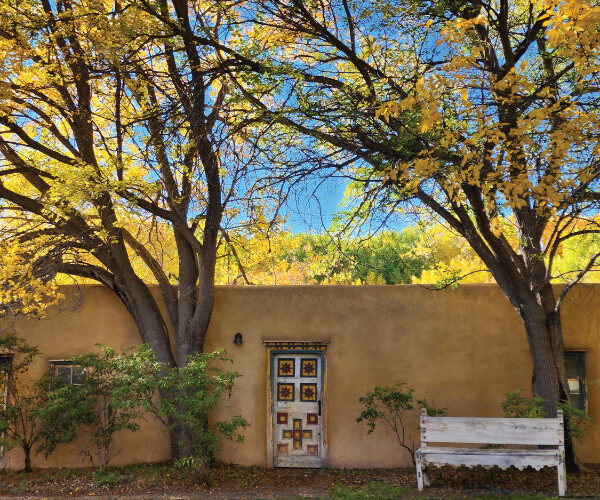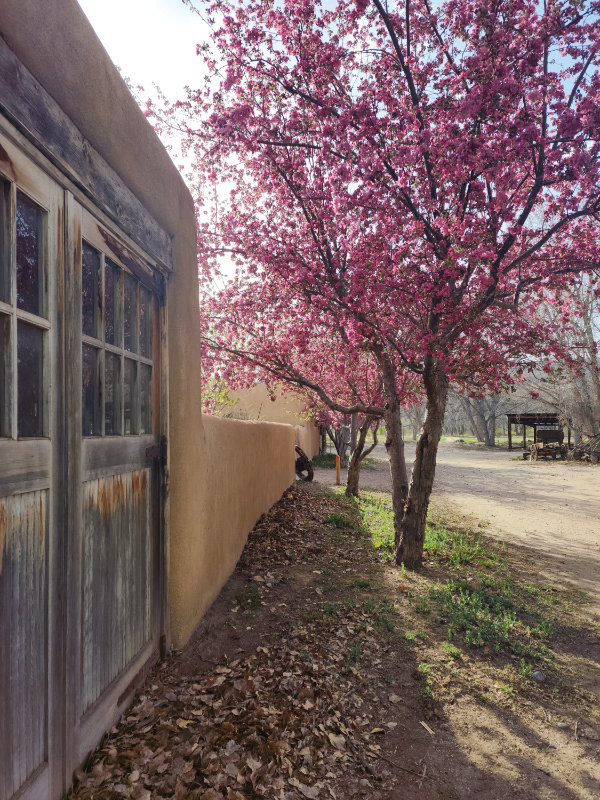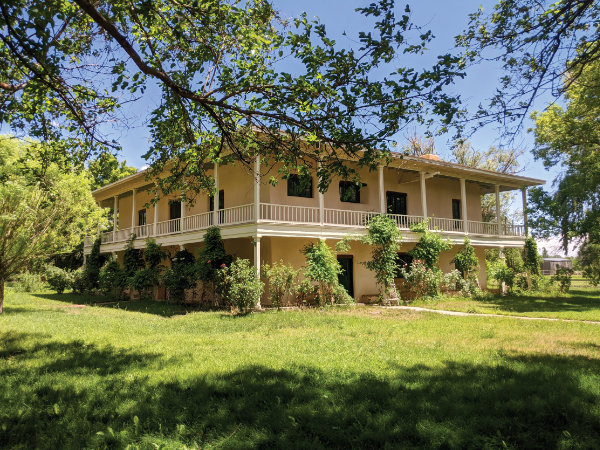Adobe Vistas
Preserving Los Luceros's Past for New Mexico's Future
 An eastern view of the almacén, featuring one of the two Folk Territorial doors that were added to the structure by Mary Cabot Wheelwright and Caroline Pfaffle in the early twentieth century.
An eastern view of the almacén, featuring one of the two Folk Territorial doors that were added to the structure by Mary Cabot Wheelwright and Caroline Pfaffle in the early twentieth century.
By Carlyn Stewart and C. I. Kieffer
Photographs by Carlyn Stewart
On a beautiful fall day in Northern New Mexico, you can take an easy drive and visit Los Luceros Historic Site in Alcalde, just north of Española between Santa Fe and Taos. While you are there, make sure to pick an apple from the historic orchard. Walk among the golden cottonwood leaves, down the dirt road, until you come to a large two-story building. Go ahead, open the green door of the hacienda—the “Great House”—and be greeted by a rush of cool air and a feeling like you’ve stepped back in time. Follow the rocky path on the bottom floor, past the staircase, all the way back to a room on the left which is decorated in a Spanish Colonial style. Here you will pass beneath a wooden Douglas fir tie beam in the doorway which was dated to at least 1805, or perhaps an even earlier date of of 1775.Though research is ongoing in this magnificent building to further pinpoint construction dates, it is interesting to think of all that doorway beam has seen. During the lifetime of that Douglas fir tree, it would have seen droughts and wet years, been passed by coyotes and mountain lions, then sheep and horses, and it would have witnessed the constant changes brought about by human innovation.
When the beam was finally installed in the building, it’s likely that it was part of a new addition to an already standing building which only had one story and a couple of rooms. Over the years it would have observed the house transform from one story to two, from outdoor kitchen to indoors; witnessed the addition of plumbing and electricity; and most importantly, it would have watched over the lives of numerous families and individuals who all left their mark on the property.
Like this beam, every bit of the architecture in this house and the nearby almacén (storehouse) has the potential to tell us something new about its history. In 2020, Los Luceros Historic Site was awarded the National Park Service’s Save America’s Treasures grant to preserve and stabilize key structures representing the cultural heritage and contributions of Northern New Mexico’s diverse ethnic and social groups, giving us the chance to learn more about one of New Mexico’s “hidden gems.”

A DEEPER HISTORY OF LOS LUCEROS
The history of Los Luceros is deeper than many realize. Numerous individuals have lived on the property, with many generations of prominent Northern New Mexico families tying into its history. However, it is important to note that the land was originally fertile agricultural land cared for by the Tewa-speaking people of Phiogeh (“flicker place”) Pueblo. They grew corn, beans, squash, amaranth, and other crops, built structures, and used complicated systems of irrigation. Descendants of those who lived at Phiogeh still live in the area today at
Ohkay Owingeh Pueblo with oral histories that say a group also migrated to Hopi Pueblo in Arizona.In 1703, Sebastián Martín Serrano and his brother-in-law Antonio Sisneros were the recipients of the 51,000-acre land grant on which Los Luceros’ 148 acres are located today, given to them by the Spanish Crown, as was common practice in Northern New Mexico at the time. After Sisneros died in 1706, Sebastián Martín Serrano bought Sisneros’ portion from his widow. Serrano had the acequia madre (mother ditch) constructed, which the site still uses to water its fields today. Archaeological testing revealed that the hacienda was likely constructed on top of an Indigenous fieldhouse, but when and by whom is still under investigation.
Soon after Bárbara Padilla (granddaughter of Sebastián Martín Serrano) and Santiago Lucero (a descendant of the Lucero de Godoy family, one of the early Spanish families of Santa Fe) married in the 1700s, the Martín family heirs began to sell their shares of the original land grant, resulting in the Lucero side owning much of the property. Julian Lucero, the nephew of Santiago Lucero and Barbara Padilla, spent much of his time as a young man buying land from Martín and Lucero heirs. By 1827 he had amassed a large land holding which he presided over as Judge of Rio Arriba County from the Los Luceros hacienda with his wife Barbara Antonia Sisneros (great-granddaughter of Antonio Sisneros), whom he had married in 1796.
Thus, the history of Los Luceros extends hundreds of years before the more popularized stories of the property that tend to feature property owner Mary Wheelwright, Diné medicine person and artist Hastíín Klah, artist Georgia O’Keeffe, writer Maria Chabot, and artist Dorothy Stewart. With a history as culturally diverse and deep as that at Los Luceros, it is no wonder that the historic district of Los Luceros was listed on the State Register of Cultural Properties in 1970 and placed on the National Register of Historic Places in 1983. It also means that the site requires more attention and care in terms of long-term preservation and stewardship.
FUNDING THE FUTURE
The NPS grant awarded to New Mexico Historic Sites provides Los Luceros Historic Site with over $450,000, with a promised match of over $750,000 between staff time and state resources. In terms of most grants, $1.2 million is sizeable. However, for preservation and restoration efforts on the scale at which they are necessary at Los Luceros, which features five historic buildings, three of which are currently open to the public, this is not enough for the entire site. In fact, some previous stewards for the site have invested millions for the general upkeep and restoration of the site. Through this grant, New Mexico Historic Sites can not only preserve and stabilize the hacienda and the neighboring almacén for generations to come, but can also find out more about their vast histories. Due to the global surge of the COVID-19 pandemic, much of the progress towards the grant’s goals were delayed until now.
Through the Save America’s Treasures Grant, problems such as moisture, roof stability, and structural issues as well as rodent, plaster, and water damage will be addressed in the hacienda and almacén.
“The hacienda and almacén are both fascinating adobe buildings, full of mystery both in the history of their construction and the history of their use,” says Shawn Evans, the project director for the MASS Design Group, which is working with Historic Sites to create a preservation plan. “We are excited for the improvements to come that will provide for better stewardship, interpretation, safety, and use. The repairs will follow the Secretary of the Interior’s Standards for the Treatment of Historic Buildings and visible changes will be quite minimal. We will know our work is successful when visitors cannot make out exactly what we did. That’s the true beauty of preservation.”

NOT THE FIRST, NOR THE LAST
This grant is not necessarily taking a revolutionary approach to the care of Los Luceros. In fact, Historic Sites is joining the revitalizations and restoration history of the property. Charles and Nina Collier purchased the house and five acres in 1959 and bought up the remaining 143 acres from Chabot in 1961. Their first restoration aimed not to modernize, but rather to restore the property to a truer version of itself: They reinforced the foundation of the hacienda, in addition to numerous other improvements to structures and the surrounding landscape (including planting the ever-popular dwarf apple trees).After their deaths, the property changed hands numerous times before 1999, when Frank and Anne Cabot (distant cousins of Mary Cabot Wheelwright) purchased the property and decided to take up the heavy responsibility of restoring the hacienda with the guidance of architect Beverley Spears and adobe restoration specialist Ed Crocker in 2000. When the Cabots were ready to hand over stewardship of the property, several organizations expressed interest.
However, in 2008, it was the New Mexico Department of Cultural Affairs under Governor Bill Richardson that decided to step up to the long-term obligation and privilege to protect, preserve, and maintain the buildings, pastures, and orchard for the enjoyment and benefit of the people of not only New Mexico, but also the United States. In 2019, Governor Michelle Lujan Grisham officially designated Los Luceros as a state historic site, which allocated funding and staff.
LOOKING FORWARD AS STEWARDS
Los Luceros is a place where people from any background can find something to connect to—whether you are a descendent retracing the steps of your ancestors through the Victorian cottage, a student on a field trip meeting the Churro sheep, a mother taking her child to pick apples at the Fall Harvest Festival, a member of the LGBTQ+ community who can identify with the queer history here (read more about that in “Spinster Acts” in El Palacio’s Fall 2019 edition), or just someone who enjoys a beautiful outdoor stroll.
New Mexico Historic Sites takes great pride in the opportunity to care for such a priceless landmark as its devoted stewards. “Our Historic Sites staff has such great passion for the history of their sites and the heritage of New Mexico,” says New Mexico Historic Sites Director Patrick Moore, “that they enthusiastically search out the means to protect our sites and follow through on major undertakings such as this makes me proud and gives me hope that future generations of New Mexicans see the importance of preserving our shared heritage.”
Today, that same Douglas fir branch in the hacienda would observe hundreds of visitors walk the same halls as the thousands before them, it would hear the heartfelt memories and spooky stories that guests share on guided tours, and it would watch as a new generation of stewards continued the work of protecting the building for the future.
—
Carlyn Stewart is an archaeologist with the New Mexico State Land Office and was previously the instructional coordinator and then site manager at Los Luceros with New Mexico Historic Sites.
C. L. Kieffer, PhD is the historic preservation and interpretation specialist with New Mexico Historic Sites and is an adjunct assistant professor (LAT) in the Anthropology Department at University of New Mexico. She currently serves as the NPS Save America’s Treasures Grant manager for the Los Luceros project.
